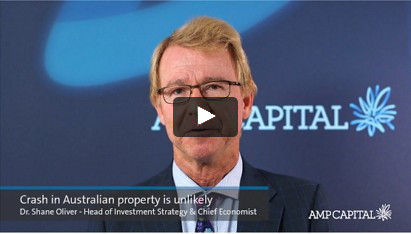The big picture view on Australian residential property is well known: Australian housing is expensive by global standards and the surge in home prices has gone hand-in-hand with a surge in household debt.
In the video below, Shane Oliver, AMP Capital’s Head of Investment Strategy and Chief Economist provides an update on Australian housing.
click to play video

Key points
-
Expensive housing and high household debt leave Australian housing vulnerable; but without a recession or much higher interest rates a property crash is unlikely.
-
The surging supply of apartments and the continuing strength of the Sydney and Melbourne property markets pose an increasing risk. Average dwelling prices in these cities are likely to see another cyclical 5-10% price downswing around 2018, with unit prices in oversupplied areas likely to decline 15-20%.
-
The combination of high house prices, huge gains in Sydney and Melbourne, low rental yields and a coming surge in the supply of apartments mean property investors need to be careful. It is best to focus on undersupplied, less-loved parts of the property market.
Crash remains unlikely
Nationwide price falls are unlikely until the Reserve Bank of Australia starts to raise interest rates again and this is unlikely before 2018 at which point we are likely to see a 5% or so pullback in property prices as was seen in the 2009 and 2011 down cycles. Anything worse would likely require much higher interest rates or recession both of which are unlikely.
However, the risks on the supply front are clearly rising in relation to apartments where approvals to build more apartments are running at more than double normal levels. Apartments in parts of Sydney and Melbourne are probably least attractive but for those who want to look around there are pockets of value.
What does this mean for investors?
Over the very long term residential property adjusted for costs has provided a similar return to Australian shares. Its low correlation with shares, lower volatility but lower liquidity makes it a good portfolio diversifier with shares. So there is clearly a role for property in investors’ portfolios.
Final thoughts
There remains a case to be cautious regarding housing as an investment destination for now. It is expensive on all metrics and offers very low income (rental) yields compared to other growth assets. This means a housing investor is more dependent on capital growth.
Source: AMP Capital 10 Jan 2017
